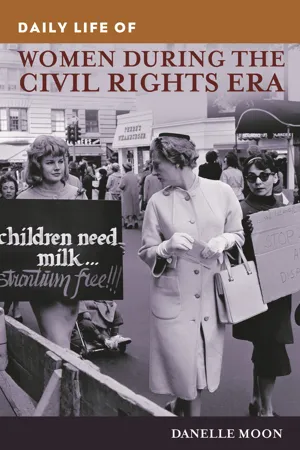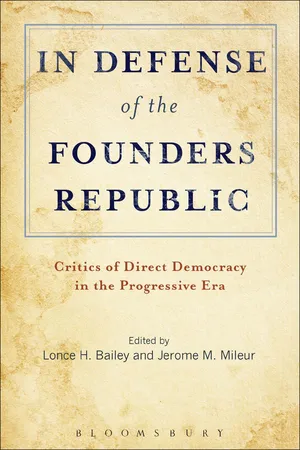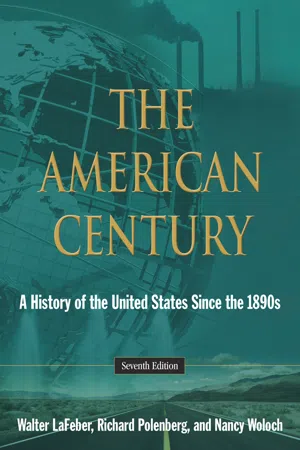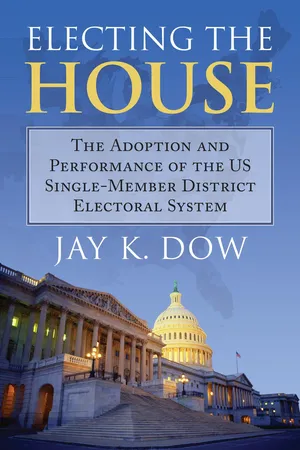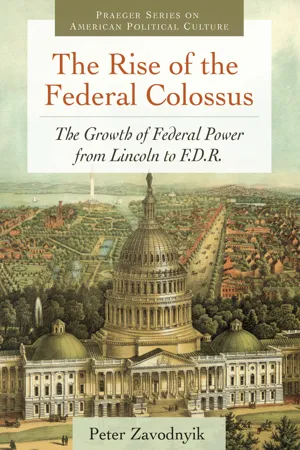History
Progressive Era Amendments
The Progressive Era Amendments refer to a series of constitutional amendments enacted in the United States during the early 20th century. These amendments aimed to address social and political issues by expanding individual rights and government regulation. The 16th Amendment allowed for a federal income tax, the 17th Amendment established the direct election of senators, and the 19th Amendment granted women the right to vote.
Written by Perlego with AI-assistance
Related key terms
1 of 5
7 Key excerpts on "Progressive Era Amendments"
- Danelle Moon(Author)
- 2011(Publication Date)
- Greenwood(Publisher)
This chapter will investigate Progressive Era reforms such as measures to improve municipal government, public health, labor legislation, educational reform, sexual legal re- forms, maternal and infant health, birth control, and postsuffrage politics that affected both women and families. First, let’s have a better understanding of the Progressive Era politics. HISTORICAL OVER VIEW OF THE PROGRESSIVE ERA Between the 1880s and the 1920s, the vast industrialization that transformed all layers of society forced many Americans to embrace a diverse series of reform efforts. Many progressives, angry about the excess of industrial capitalism and urbanization, pointed to the dangers of factory life and the squalor of tenement housing. They believed that social and economic conditions could be improved Women and Reform in the Pr ogr essive Era, 1880s to 1930 23 and were optimistic that American democratic government had the potential to address these social ills. They also firmly believed that the best way to change society was through voting, litigating bad practices in the courts, and congressional legislation. In contrast to the individualistic ideology of the 19th century, progressive re- formers believed that collective action was necessary to produce a viable society whereby big government provided the resources to take care of the collective whole. Some reformers focused on the ex- pansion of legislation regulating government, business, and labor, while others focused on expanding civil rights, expanding educa- tion, building kindergartens, creating local playgrounds and na- tional parks, improving public health including infant, child, and maternal health, and eradicating poverty in urban areas. What did it mean to be a progressive? The early histories of the progressive movement focused on the role of the great white male leaders and their battle with the Republican Party and the rail- roads.- eBook - ePub
In Defense of the Founders Republic
Critics of Direct Democracy in the Progressive Era
- Lonce H. Bailey, Jerome M. Mileur(Authors)
- 2015(Publication Date)
- Bloomsbury Academic(Publisher)
The only Progressive reform to be adopted at the national level was the Seventeenth Amendment which provided for the popular election of US Senators. Consistent with their view of direct democracy, this change derived primarily from the desire to weaken the power of state legislatures, and therefore the party machines that controlled them, that had previously made the choice of Senators. The ballot was also spread more widely after World War I by ratification of the Nineteenth Amendment which gave the vote to women. This was consistent in spirit and purpose with Progressivism, but credit for the amendment’s success goes primarily to women’s organizations who had pressed the cause for almost a century. There was also a strain in Progressivism that sought to limit access to the ballot to new immigrant groups, and of course reformers did nothing to bring the vote to racial minorities in the South.The bookThere is a rich literature on the effect of Progressive reforms on the development of the American national government and politics, the rise of an administrative state with the presidency at the center, the growth in the size of government and the reach of public policy, and the expanded role of citizens and experts in its direction and management. This literature has focused on the intent of the Progressives, the content of their reforms, and the consequences for the nation’s governance. Little attention, however, has been paid to the debates that attended these reforms. There were anti-federalists as well as federalists at the time of the Constitution’s ratification, and the thought of both has been explored often and at great length. There is no comparable record for the Progressive Era. The critics of Progressive reforms—the anti-progressives, so to speak—have largely passed from historical accounts of the time. Insofar as attention is given to them, they are usually characterized as conservatives defending a status quo of capitalists and party bosses exploiting the masses, indifferent to the public good, turning America into something its founders had not intended. This depiction may be correct for some of the critics, but others offered a spirited defense not of the economic and political status quo but of the principles and logic of the Framers’ Constitution that had governed the nation for a century. The recovery of their thought, especially their criticism of direct-democracy and direct-government reforms which is the focus of this volume, sets the Progressive Era in a larger frame that lends credence to the contention that the period was less a time of mere reform and more one that constituted a second founding of the nation. A more complex understanding of the debates and conflicts of the time will broaden our view of this important reform picture and its resultant consequences. - eBook - ePub
Liberty and Union
A Constitutional History of the United States, volume 2
- Edgar J. McManus, Tara Helfman, Edgar McManus(Authors)
- 2013(Publication Date)
- Routledge(Publisher)
Dillon as whether it had been ratified at all. The National Prohibition Act under which the petitioner had been convicted contained a provision that it would take effect one year after ratification of the amendment. Ratification by three-fourths of the states occurred on January 16, 1919, but the Secretary of State did not proclaim the amendment ratified, as required by an act of Congress, until January 29, 1919. The petitioner had been arrested for illegally transporting wine on January 17, 1920, so the time gap between ratification and proclamation was crucially important. He contended that the National Prohibition Act did not take effect until January 29, 1920, one year after the amendment had been proclaimed, and that it therefore did not apply to him. The Court rejected this argument, holding that the amendment became part of the Constitution on January 16, 1919, when approved by three-fourths of the states. The delay in proclaiming the amendment had no legal or constitutional consequences. Amendments automatically become part of the Constitution when ratified by the requisite number of states.Women’s RightsThe women’s suffrage movement was another nineteenth-century crusade that drew strength and support from progressivism. Unlike prohibition, which carried heavy moral and religious freight, women’s suffrage meshed neatly with the secular goals of political reform. Many progressives supported the movement not just on grounds of fairness but in the belief that the entry of women into political life would help the reformers in breaking the power of male political bosses. But progress was painfully slow. As late as 1914, women had gained the same political rights as men in only nine of the states. Frustrated at the state level, the movement shifted gears and launched a campaign for a constitutional amendment mandating the political equality of the sexes.Figure XIV.6 Photo of suffragist Florence Jaffray “Daisy” Harriman holding a banner reading, “‘Failure Is Impossible’—Susan B. Anthony—Votes for Women” (c. 1910–15). Harriman was a social reformer, an advocate for women’s rights, and, later in her career, U.S. Minister to Norway during WWII.Library of Congress, Prints and Photographs Division, [LC-DIG-ggbain-12783]Women’s Rights“It was we, the people; not we, the white male citizens; nor yet we, the male citizens; but we, the whole people, who formed this Union. And we formed it, not to give the blessings of liberty, but to secure them; not to the half of ourselves and the half of our posterity, but to the whole people—women as well as men. And it is a downright mockery to talk to women of their enjoyment of the blessings of liberty while they are denied the use of the only means of securing them provided by this democratic-republican government—the ballot…. For any state to make sex a qualification that must ever result in the disfranchisement of one entire half of the people, is to pass a bill of attainder, or, an ex post facto law, and is therefore a violation of the supreme law of the land. By it the blessings of liberty are forever withheld from women and their female posterity.” - No longer available |Learn more
The American Century
A History of the United States Since the 1890s
- Walter LaFeber, Richard Polenberg, Nancy Woloch(Authors)
- 2015(Publication Date)
- Taylor and Francis(Publisher)
HAPTER TWO 1900—1917The Progressive EraSuffragists on a picket line in front of the White House. One banner reads, "Mr. President How Long Must Women Wait For Liberty." (Library of Congress)An interest in reform has always characterized American history. What varied over time has been the things people identified as evils, the intellectual justifications and political techniques used to eradicate those evils, the obstacles reformers encountered, and the degree of support those reforms received. Seldom has a larger proportion of the population favored social improvement than during the opening years of the twentieth century, when Americans first tried in a systematic way to control the forces of industrialization and urbanization. Because the United States was becoming a major world power, the successes and failures of the Progressive movement affected not only Americans but also people around the world.The Reform Impulse
Although progressivism followed on the heels of the Populist revolt and sometimes echoed certain Populist demands, the two movements differed in important respects. Populism had drawn support primarily from farmers and had always remained a sectional force; progressivism won backing from city dwellers, including the middle classes, and had as wide a following in New York and California as in Kansas and South Carolina. Populists had sought for the most part to improve conditions in the countryside; Progressives devoted considerably more attention to political and social problems in the cities. Precisely because Progressives drew on a wider constituency and were concerned with a broader range of issues, they achieved a measure of influence at the city, state, and national levels that had eluded the Populists.Progressives did, however, pay a price for this success. So many different people wanting so many disparate things styled themselves "Progressives" that the movement often seemed to lack a clearly defined program. Progressivism attracted surprisingly diverse groups: small businessmen who favored a curb on monopolies, and big businessmen who sought to extend their economic influence and eliminate their competitors; native Americans who feared the influx of eastern European immigrants, and settlement-house workers who appreciated the newcomers' contributions to American culture; southern whites dedicated to the preservation of Jim Crow, and northern blacks just as fully committed to its eradication; social scientists who believed that planning held all the answers to human progress; and prohibitionists who imagined that closing the saloons would usher in a new world. - eBook - ePub
Electing the House
The Adoption and Performance of the U.S. Single-Member District Electoral System
- Jay K. Dow(Author)
- 2017(Publication Date)
- University Press of Kansas(Publisher)
This stability belies the extraordinary electoral changes that were imposed in the Populist and Progressive Eras. The period’s lasting legacy is a collection of laws that fundamentally and irrevocably changed how elections are contested. Collectively known as the Progressive Reforms, these included the introduction of the secret ballot; the passage of the Seventeenth and Nineteenth Amendments, respectively providing for the direct election of US senators and the enfranchisement of women; primary elections and the introduction of state-level voter registration; initiative, referendum and recall elections; campaign finance regulation; nonpartisan municipal elections; and a host of other laws that structure elections to this day. Indeed, the vast corpus of current laws regulating the electoral activities of political parties, candidates, and citizens dates to these years. The Progressives had a clear political agenda; they sought to reduce the power of political parties, their leaders (or bosses if one prefers the pejorative term), and the economic interests that relied on their political protection. For the Populists and Progressives, “the only proper party was the people themselves; the only valid laws. . . were the people’s truths phrased in the people’s language.” 24 Perhaps less appealing to modern sensibilities, the Progressives were also deeply apprehensive of citizen engagement in the politics, especially participation by immigrants and African Americans. John R - eBook - PDF
The Rise of the Federal Colossus
The Growth of Federal Power from Lincoln to F.D.R.
- Peter Zavodnyik(Author)
- 2011(Publication Date)
- Praeger(Publisher)
and recall as devices through which the influence of bosses and lobbyists might be overcome. A series of newspaper and magazine articles of 1905 and 1906 that revealed the extent to which commercial interests had corrupted legislatures and municipal governments gave new momentum to the drive for political reform. Aided by the public’s negative reaction to these revelations, reformers succeeded in loosening the grip of corpora- tions over state legislatures; perhaps the most famous revolt took place in California, where the Southern Paci fic ’ s stranglehold over the state government came to an end. The Progressive movement enjoyed more successes in some states than others; in those states that had not suffered a plague of public corruption, it contributed little. Massachusetts main- tained its long tradition of responsive government throughout the late nineteenth century despite urbanization and the rise of powerful industrial concerns; consequently it did not require or witness an upheaval of the type that occurred in so many other states. 278 The most important progressive reform for the federal system was the Seventeenth Amendment’s transfer of the power to elect U.S. senators from legislatures to the electorates of each state (though 29 states had already provided for a popular vote in the election of U.S. senators by 1909). 279 The Seventeenth Amendment arose out of the corruption of state legisla- tures by corporate interests who were thought to exercise too much influ- ence in the election of senators. It also stemmed from the growing problem of the two houses of legislatures being deadlocked over the election of U.S. senators and depriving their states of representation in the U.S. Senate for weeks, months, and even years. By one count, there were over 70 such dead- locks between 1870 and 1913. - eBook - PDF
- John E. Findling, Frank W. Thackeray, John E. Findling, Frank W. Thackeray(Authors)
- 2010(Publication Date)
- ABC-CLIO(Publisher)
Supporters, who tended to believe that alcohol, frequently manufactured by immigrant-run enterprises, was the root cause of poverty and crime, were wholly unprepared for the levels of lawlessness ushered in by Prohibition. The amendment granting women the right to vote may have drawn as much from growing nativism, or opposition to immigrants, as it did from the arguments of femi- nists. After over years of agitation for female suffrage, women’s efforts on behalf of Progressive reform had clearly demonstrated both that women were capable of intelli- gent decision making and that office-holders were unresponsive to the petitions of vote- less segments of society. Sadly, the most persuasive argument to many was that it was unfair and unwholesome that women from nice native-born prosperous households could not vote while immigrant and African American men could. The ratification in of the Nineteenth Amendment, which granted women the vote, thus stands as pe- culiar testimony to the convergence of reform and reaction. Little was done in the way of national legislation to improve the circumstances of life for the poor, whose distress had prompted the initial call to reform. While Theo- dore Roosevelt may have begun using the presidency as an ostensibly neutral mediator in disputes between labor and capital, striking workers during and after World War I found that the federal government would be impartial only when convenient. Antitrust legislation, one of the main victories of the Progressives, soon was used more to impede the development of labor unions than to stop predatory business practices. Real reform for workers had to wait until the New Deal’s response to the Great Depression in the s. African Americans benefited in the Progressive era more from the circumstan- tial prosperity of the two decades after than from any activity pursued by govern- ments at any level.
Index pages curate the most relevant extracts from our library of academic textbooks. They’ve been created using an in-house natural language model (NLM), each adding context and meaning to key research topics.
